How to Rank Using Black Hat SEO Tactics in a White Hat Way

Key Takeaways
- Black hat SEO techniques, while traditionally seen as manipulative and against search engine guidelines, can be repurposed in a white hat manner to improve site rankings without incurring penalties.
- Link wheels, a once-popular black hat technique, can be reimagined by creating a series of high-quality guest posts on authoritative sites, each linking to the next and to your main site, creating a “wheel” of links that pass authority and relevance.
- Blended link building, another black hat strategy, can be used ethically by creating high-quality resource content that others want to link to, and strategically placing your links alongside other authoritative sites.
- Scraping, a black hat practice of choice, can be used effectively to analyze your website for technical SEO issues, or to find contact details for relevant webmasters for outreach and relationship building, rather than for spamming purposes.

This article was originally published on Single Grain.
At first sight, link building seems so darn simple, doesn’t it?
You just need to pick keywords you want to rank for, create amazing content, ask other bloggers to link to your expert piece in their posts, and BAM! As if by magic your site begins to climb up in SERPs.
Sure, there are some intricacies and ranking factors that you need to keep in mind when building links. For instance, as much as 21% of your SEO success depends on the anchor text you use on external links and 22% on link popularity.
So as long as you follow these steps, you should be fine, right?
Tell me… how do you stay ahead when everyone else is doing exactly the same thing?
Increase your efforts?
Launch more content?
Or…turn to strategies that your competitors would prefer to stay away from, like black hat techniques but used in a white hat way?
That’s exactly what I’m going to show you in this post: a couple of black hat SEO strategies that you can use without breaking Google’s guidelines in order to rank higher, attract more traffic, and increase conversions.
But first, a quick recap…
What is (or Better Yet, WAS) Black Hat SEO?
The term black hat refers to aggressive SEO strategies that violate the search engine’s guidelines and best practices.
The basic recognizable trait of black hat SEO is its disregard for users and its sole focus on manipulating search engines and rankings.
Black hats used strategies like article spinning, content automation, and keyword stuffing to manipulate rankings and position low-quality content in the search results. They would also build link wheels and cloak links, create doorway pages, and use tiered link building.
Eventually Google caught on and tackled black hat practices by publishing Google Penguin, an update to the search results ranking algorithm Google Panda. From then on, a website would be penalized by Google when using black hat tactics.
However, I’m going to show you how to incorporate these strategies in your link-building campaigns in a white hat way to help skyrocket your organic traffic.
Tactic #1. Link Wheels
Link wheels were a breakthrough link-building technique only a couple of years ago. Even some well-known white hat SEOs praised their ability to influence a site’s rankings in Google.
Black hats used link wheels to increase the strength of the links that they generated and, in turn, propel their sites higher up in the search results.
The premise behind link wheels was simple:
To create a pattern of sites linking from one to another and also your main site. Each site in the wheel would power up the next spoke. And since it was a closed system, in theory their authority would constantly continue to grow, in turn sending a stronger link to your main site.
Here’s what a basic link wheel looked like:
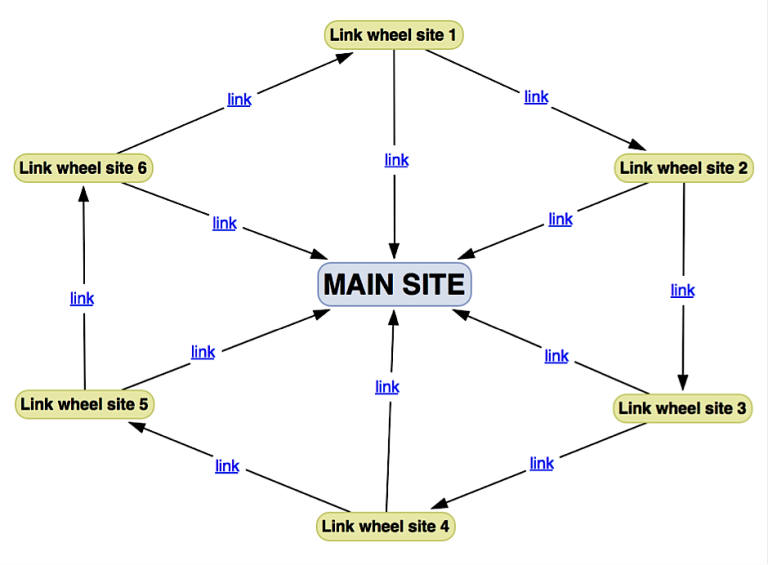
To create link wheels, SEOs used high PR Web 2.0 properties (free blogging platforms like Tumblr, WordPress.com or Blogger.com) or article directories (like ezinearticles.com).
They created free sites on these properties, added some content (typically just one article), supplemented it with low-quality, spun posts, and included links to the next spoke in the wheel as well as to the main site.
Eventually the search engines began considering link wheels a manipulative strategy.
But here is the catch:
The biggest problem with link wheels wasn’t the wheel itself but what black hats used to build them with.
Let’s face it, free Web 2.0 properties featuring low-quality, spun content offered no value for the user. That, in turn, made the whole strategy vulnerable to the search engines’ scrutiny.
Here’s an example of a link wheel service on a black hat forum:
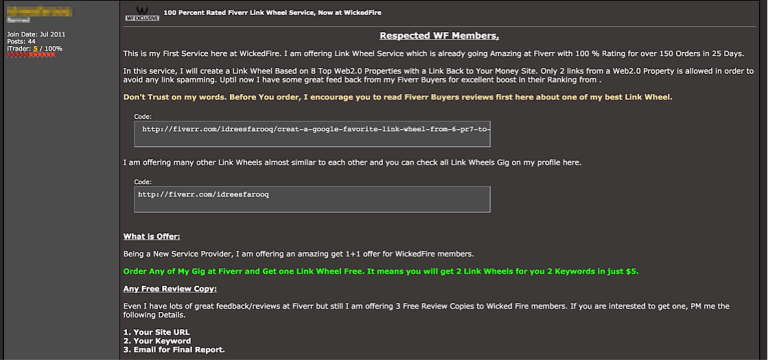
Keep in mind that the concept of a link wheel works.
And you could still use it today. However, you just need to build a link wheel from reputable resources.
Instead of using Web 2.0 properties, free blogging sites or article directories, build link wheel spokes from real websites with whom you have developed a relationship.
For example, let’s assume that you want to build links to an online store selling bicycle storage systems. You could write a series of guest posts on authoritative cycling sites, each covering different aspects of bicycle maintenance. Then you could link those articles as spokes in the link wheel as well as include a reference to your store from each article.
This way you are creating a link wheel that:
- Is built on high quality sites
- Offers high value to users
- Passes high PR to your main site
TIP: To ensure that the link wheel does not fall under Google’s scrutiny, don’t link back to your home page from each spoke. Instead, create another highly-relevant resource and reference it from each article.
Your link wheel would then look more or less like this:
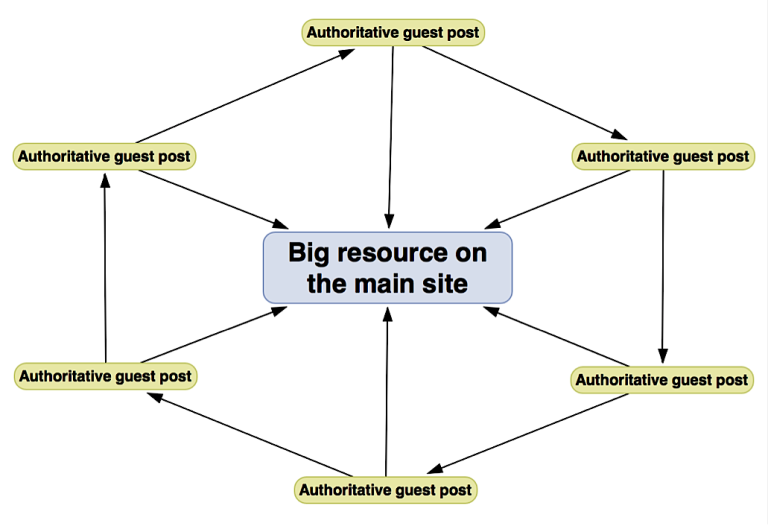
Tactic #2. Blended Link Building
You don’t always need more links to increase a site’s rankings.
Which is the premise of another black hat strategy, known as “Blended Link Building.”
You see, by including a reference to your site among links to other highly-authoritative sites (such as Wikipedia, New York Times, etc.), you can fool Google into treating your site the same way it treats those other sites—and, in turn, granting your site higher rankings.
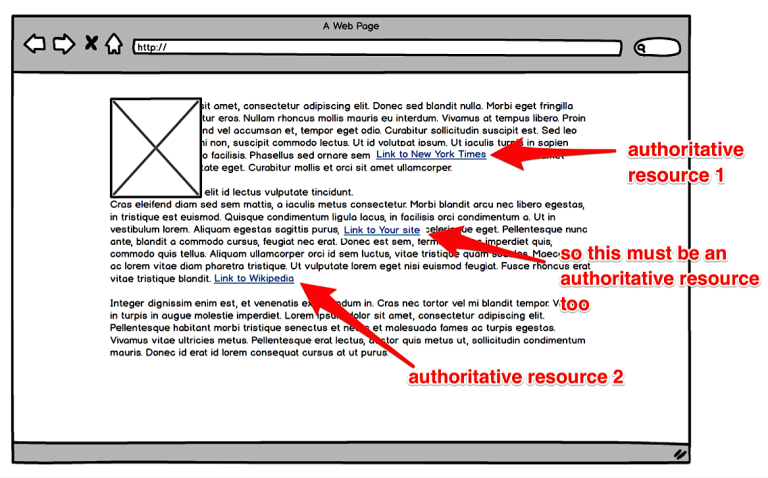
To use this strategy, black hats would either find someone willing to link to their site as well as certain relevant authoritative sites or create those resources themselves.
To do this, black hats would again resort to using Web 2.0 blogs, article directories, and other properties on which they could control the content in order to blend their links with authoritative websites.
But again, using these web properties made the strategy vulnerable to search engine penalties.
Blended link-building techniques, on the other hand, still work. You just need to be more strategic about how you do it.
Here’s how I recommend you build blended links:
Start by creating awesome resource content that others would be willing to link to.
This could be a list of statistics, a resource page or a compilation of research findings, for instance. The key is to provide high-quality information that writers and content creators can reference in their own copy.
Why does this work?
Because they are constantly looking for resources to enrich their blogs and articles. They know that by including or referencing relevant statistics, research findings, graphs, statistics, numbers, etc., they increase the perceived authority of their content.
From now on, your strategy can work two ways:
Option 1:
Find pages that already link to similar resources as your own and suggest yours for potential inclusion. Outreach the webmasters, bloggers or editors and outline the benefits of referencing your content in their piece.
Option 2:
Guest post on the industry’s top sites. Include links to relevant and authoritative resources in the content, along with the link to your own resources.
Note: Many authoritative sites don’t allow you to link back to an author’s site from the content, but if you have created a highly-relevant and amazing resource, their editors might be persuaded to link to it.
Bonus:
To (passively) build even more blended links, optimize your resource for keywords that writers and content marketers might use when looking for reference material. For instance:
- “[topic] + research”
- “[topic] + stats”
- “[topic] + statistics”
This way you can ensure that they find and include your content among other authoritative resources.
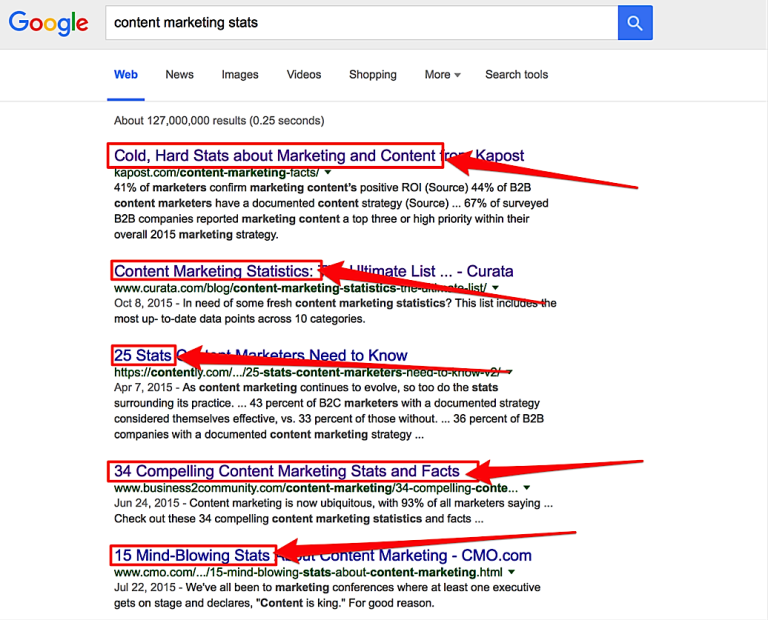
Top results for “content marketing stats” query. Guess how many writers link to or reference them every month?
Tactic #3. Tiered Link-Building
I’m sure you already know this, but it bears repeating: the more authoritative the page that links to you, the stronger the backlink.
It is, however, extremely difficult to build links only from high-authority sites.
Well, black hat SEOs came up with a simple solution—build links to pages that already link to them in order to increase their authority and rankings.
This method is known as tiered link-building.
Black hats would build tiers of links, with each link pointing back to the previous one, ultimately strengthening the backlink.
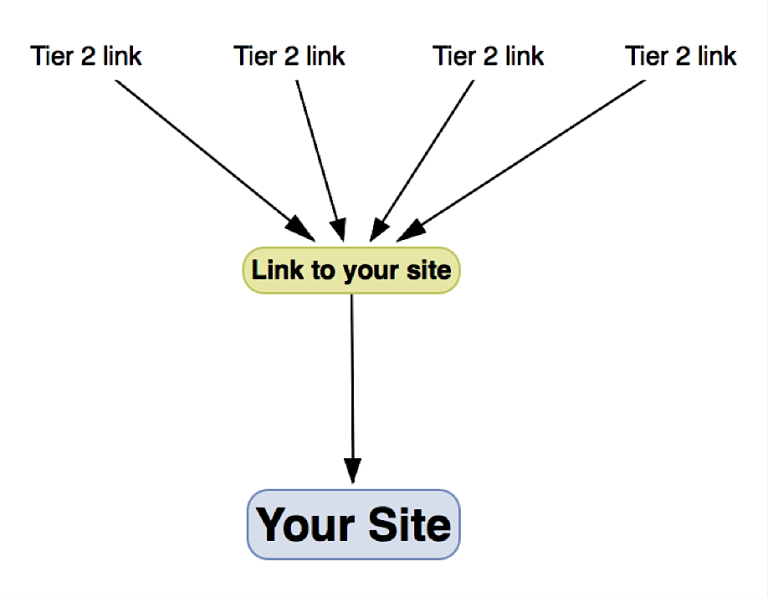
Once again, black hats would use Web 2.0 blogs and other web properties to build tiers. And once more, it made the strategy vulnerable.
But building tiered links and strengthening backlinks wasn’t a bad idea.
In fact, you can certainly still use them today to improve your rankings. How? By using guest posts to link to resources that already link to you.
So every time you write a guest post, think about whether there is any relevant content linking to you that you can reference in the post.
By sending a couple of links to that page you can strengthen it and ensure that it begins to rank in the first 100 results for the key phrase, making it a highly-relevant link source.
Tactic #4. Contact Scraping
Scraping was THE black hat practice of choice.
Using apps like Scrapebox, black hats would scour the web in search of anything from webmasters’ contact details to keywords to content. They would then use this information to send automated link requests, spam sites with gibberish comments, and even create spun variations of the content they found.
Naturally, all this resulted in nothing more than an increase of spam across the web.
But scraping in and of itself isn’t such a bad practice.
You see, the power of scraping lies in its ability to find information at scale.
A scraping tool can help analyze your website for technical SEO issues, for instance. Bartosz Góralewicz posted a thorough tutorial on using Scrapebox to detect and solve many technical SEO problems.
It can also help you find contact details for webmasters who manage sites that are relevant to you. It’s just that instead of spamming them with irrelevant messages, you use this information to reach out and build connections that could result in links down the line.
For example: imagine that you’re running a broken link building campaign. You’ve found websites that contain broken links and you want to reach out to them to offer your resource as a replacement.
But first you need to find those webmasters’ contact details. One way is to simply visit each site and manually retrieve this info. Of course, depending on the size of your list, that could take hours upon hours.
So to speed it up, you can scrape a list of domains in minutes to receive the information that you require. From then on you can use automated outreach software like Salesloft Sales Dialer or Growbots to reach out and connect with those people.
In this instance, the point of using scraping isn’t to generate spam but simply to scale your efforts.
In fact, scraping is a popular strategy today. For instance, salespeople rely on scraping in their lead generation efforts. They use such apps as SalesLoft Prospector, LeadFuze, import.io, and Grabby to extract contact details from LinkedIn profiles or websites and add the info to their CRM systems in order to connect.
Conclusion
Link building might seem easy at first. But there are many intricacies in the process and certain steps to follow in order to expand your link profile.
So how do you stay ahead when everyone’s doing the same thing?
My answer: use tactics and strategies that your competitors prefer to stay away from—black hat SEO. But always in a white hat way.
When used properly and with integrity, these tactics can help propel your site higher in search results, attract more traffic, and increase conversions.
What about you? Have you used, or seen others using, any other black hat SEO strategies in a white hat way? Share them with us in the comments below!
Frequently Asked Questions about Black Hat SEO Tactics
What are the potential risks of using Black Hat SEO tactics?
Black Hat SEO tactics, while potentially effective in the short term, carry significant risks. These include penalties from search engines, which can drastically reduce your site’s ranking or even remove it from search results altogether. Additionally, these tactics can damage your brand’s reputation, as they are often seen as unethical or deceptive. It’s important to weigh these risks against the potential benefits before deciding to use Black Hat SEO tactics.
How can I use Black Hat SEO tactics in a White Hat way?
The key to using Black Hat SEO tactics in a White Hat way is to focus on providing value to your users. For example, keyword stuffing is a Black Hat tactic, but you can use keywords effectively by incorporating them naturally into high-quality, relevant content. Similarly, while buying links is considered Black Hat, you can build links ethically by creating valuable content that others want to link to.
What is the difference between Black Hat and White Hat SEO?
Black Hat SEO refers to aggressive tactics that focus solely on search engines and not a human audience, often violating search engine guidelines. White Hat SEO, on the other hand, refers to tactics that are in line with search engine guidelines and focus on providing value to users.
Can Black Hat SEO tactics lead to a permanent ban from search engines?
Yes, if a website is found to be using Black Hat SEO tactics, search engines like Google can impose severe penalties, including permanently removing the site from their search results. This is why it’s crucial to understand the risks involved and use these tactics responsibly.
What are some examples of Black Hat SEO tactics?
Some common Black Hat SEO tactics include keyword stuffing, using invisible text or hidden links, creating doorway pages, and using duplicate content. These tactics are designed to manipulate search engine algorithms and can lead to penalties if detected.
How can I detect if a website is using Black Hat SEO tactics?
There are several signs that a website might be using Black Hat SEO tactics. These include overuse of keywords, hidden text or links, sudden spikes in traffic, and low-quality or duplicate content. Using SEO analysis tools can also help detect these tactics.
Are there any legal implications of using Black Hat SEO tactics?
While not illegal in the traditional sense, Black Hat SEO tactics can lead to penalties from search engines, including removal from search results. Additionally, some tactics, like hacking into other websites to build links, can have legal consequences.
How can I recover from a penalty due to Black Hat SEO tactics?
Recovering from a penalty requires identifying and correcting the Black Hat SEO tactics that led to the penalty. This might involve removing or replacing low-quality content, eliminating hidden text or links, or disavowing bad backlinks. It’s also important to develop a long-term SEO strategy that focuses on White Hat tactics.
Can Black Hat SEO tactics still be effective in today’s search landscape?
While some Black Hat SEO tactics can still yield short-term results, search engines are becoming increasingly sophisticated at detecting and penalizing these tactics. Therefore, they are generally not recommended for a sustainable, long-term SEO strategy.
What are some ethical alternatives to Black Hat SEO tactics?
Ethical alternatives to Black Hat SEO tactics, often referred to as White Hat SEO, include creating high-quality, relevant content, using keywords naturally and appropriately, building links organically, and focusing on providing a good user experience. These tactics are not only more likely to avoid penalties, but they can also lead to more sustainable, long-term success.
Eric Siu is the founder of Growth Everywhere, a podcast where he interviews world-class entrepreneurs on business and personal growth. He is also the CEO of digital marketing agency Single Grain. You can follow Eric on Snapchat here.


